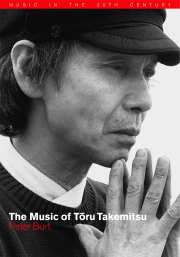Book contents
- Frontmatter
- Contents
- Acknowledgements
- Note on conventions
- Introduction
- 1 Pre-history: how Western music came to Japan
- 2 Music and ‘pre-music’: Takemitsu's early years
- 3 Experimental workshop: the years of Jikken Kōbō
- 4 The Requiem and its reception
- 5 Projections on to a Western mirror
- 6 ‘Cage shock’ and after
- 7 Projections on to an Eastern mirror
- 8 Modernist apogee: the early 1970s
- 9 Descent into the pentagonal garden
- 10 Towards the sea of tonality: the works of the 1980s
- 11 Beyond the far calls: the final years
- 12 Swimming in the ocean that has no West or East
- Notes
- List of Takemitsu's Works
- Select bibliography
- Index
12 - Swimming in the ocean that has no West or East
Published online by Cambridge University Press: 18 August 2009
- Frontmatter
- Contents
- Acknowledgements
- Note on conventions
- Introduction
- 1 Pre-history: how Western music came to Japan
- 2 Music and ‘pre-music’: Takemitsu's early years
- 3 Experimental workshop: the years of Jikken Kōbō
- 4 The Requiem and its reception
- 5 Projections on to a Western mirror
- 6 ‘Cage shock’ and after
- 7 Projections on to an Eastern mirror
- 8 Modernist apogee: the early 1970s
- 9 Descent into the pentagonal garden
- 10 Towards the sea of tonality: the works of the 1980s
- 11 Beyond the far calls: the final years
- 12 Swimming in the ocean that has no West or East
- Notes
- List of Takemitsu's Works
- Select bibliography
- Index
Summary
By choosing a scenario about whales for his abortive opera project, Takemitsu was reflecting a preoccupation that had long been dear to his heart. More than once in his final years – for example in a letter sent to Peter Serkin a few days before his death – he expressed a wish to ‘get a more healthy body as a whale’ and ‘swim in the ocean that has no west and no east’. Takemitsu's choice of words here evokes more than simply his whimsical intention to be reincarnated as a whale; it is also poetically suggestive of his lifelong quest as an artist for a kind of cultural transcendence, an internationalism of outlook. In this final chapter, I propose to discuss the degree to which Takemitsu may have been successful in the realisation of more general, aesthetic goals of this sort, and thus try to arrive at some kind of critical assessment of his status as a composer.
It is important at the outset of any such discussion to draw attention to the precise wording of Takemitsu's wish: he wishes to swim in an ocean that has neither West nor East, not in one that somehow links the two. One still comes across the misunderstanding that Takemitsu saw himself in some way as a bridge between these two cultures, perhaps because the early success of November Steps left some listeners with the indelible impression that his life's work was devoted to reconciling the differences between the symphony orchestra and the shakuhachi.
- Type
- Chapter
- Information
- The Music of Toru Takemitsu , pp. 234 - 253Publisher: Cambridge University PressPrint publication year: 2001



